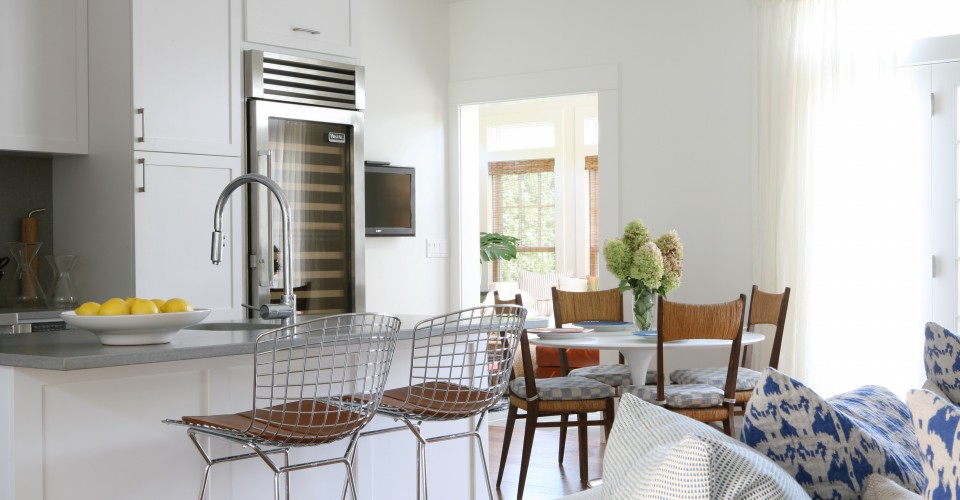Most homeowners dream of having a newly remodeled kitchen, complete with the latest appliances and updated countertops, without spending too much money. Before you start scrapbooking kitchen ideas or shopping for a new appliances, be sure that your dream kitchen is based on a realistic budget. Sticking to a budget, and not overspending, is an important part of being a smart homeowner. Managing scope creep (the temptation to remodel beyond your means), and accounting for the inevitable unplanned costs along the way, will enable you to get the kitchen you’ve always wanted while adding value to your home.
Kitchens, according to most real estate agents, can really make or break a good first impression. Creating an on-trend kitchen, with appropriate upgrades, will go a long way towards increasing the value of your home. Use this guide to help you set the best kitchen remodeling budget for your home.
1. Understand what the average kitchen remodel costs
According to Remodeling Magazine, the national average cost of a mid-range, major kitchen remodel (which includes updating a 200-square-foot kitchen with 30 linear feet of semi-custom cabinets, a 3-by-5-foot island, laminate countertops, double-tub stainless-steel sink with single faucet, energy-efficient appliances, custom lighting, new flooring and fresh paint) costs $54,909 and has an average return on value of 74.2%.
The national average cost of a mid-range, minor kitchen remodel (using the same outdated, 200-square-foot kitchen and 30 linear feet of cabinetry boxes left in place but with new fronts and hardware, new energy-efficient appliances, new laminate countertops, sink and faucet, new resilient flooring and fresh paint) costs $18,856 and has an average return on value of 82.7%.
2. Know how much a typical kitchen remodel costs in your neighborhood
Before you set your budget, compare your kitchen remodel to comparable homes in your neighborhood. Start by downloading the free Porch Home Report for your home and listed homes near you. Keeping your remodeling scope and costs comparable with your neighbors will enable your home to be competitive on the market. It’s important that your remodeling plans should relate to your type of home. Prospective home buyers, for example, expect that a multi-million dollar home would incorporate top-end appliances, high-end materials, and employ a professional designer. Keeping your kitchen remodel proportionate to what is typical for your neighborhood, or your home’s valuation, will ensure that your home remains competitive when it’s time to sell.
3. Make a list of your kitchen priorities
Kitchens encompass a wide range of materials and components, all of which have varying degrees of cost. Setting the budget may mean making compromises. If you consider yourself an at-home chef and absolutely must have a high-end gas range, be prepared to allocate more of your budget towards appliances (and possibly installing a gas line). If an ecologically friendly kitchen is important to you, then realize you may be limited in your choices of materials. You may want marble countertops but might not be able to afford the higher installation and maintenance costs associated with that material. Be realistic about the components you need versus the items you want.
4. Know how to determine the kitchen remodel budget
In order to set an appropriate budget for your kitchen remodel, you’ll want to have clear expectations when it comes to the main motivation for remodeling. If you plan on selling your home in the next few years, consider making upgrades that are comparable with competitive homes in your neighborhood. If your kitchen is the first of many rooms in your home to be upgraded, consider how you will afford all the projects you want to complete. If you plan on living in your home for a very long time, and your kitchen remodeling project is primarily for your own enjoyment, be sure that your wish list is affordable. In determining how much money to spend on a kitchen remodel, many experts recommend using a percentage of your home’s valuation. It’s recommended to spend about 5% – 15% of your home’s valuation for a kitchen remodel. If your home was valued at $500,000, for example, and you’ve selected to use 15% of your home value for renovation, your budget would be $75,000 for a kitchen remodel.
5. Know where the money goes
Whether you choose a major or minor project, a kitchen remodel entails many components with varying costs. The below percentage allocation guide can be used as an estimate in setting your budget (note that this allocation model does not include design fees, permitting fees or any miscellaneous costs such as eating out more or living in a temporary home during the remodel).
- Appliances: 19% (about 7% of this cost will be for labor)
- Cabinetry: 48% (18% for labor)
- Countertops: 15% (18% for labor)
- Faucets and plumbing: 5% (30% for labor)
- Flooring: 5% (40% for labor)
- Lighting & Electrical: 5% (30% for labor)
- Walls & Trim: 3% (50% for labor)
6. Be prepared for unexpected kitchen remodeling costs
Be sure to allocate about 20% of the budget for unexpected costs. Unexpected costs can include discovering damage due to water or termites, adding additional support for flooring or appliances, electrical or plumbing challenges, or any unforeseen, but necessary, subcontractors (like asbestos removers). You may also find yourself adding on to the kitchen remodeling project, commonly known as “scope creep.” Don’t forget that while remodeling your kitchen, you may have need for eating out more often or temporarily staying in another location. All of this may add to your bottom line.
7. Decide how you will finance your kitchen remodel
Sit down with your family and possibly your financial advisor to determine the right course of action for paying for your kitchen remodel. Borrowing a big chunk of cash is not always the best course of action, and being able to save before you spend is usually the most financially prudent way to remodel. Of course many homeowners look to securing a line of credit or decide to refinance. Speak with your mortgage broker or financial advisor to understand your best course of action and be sure to shop around. Before you meet with an advisor, have a general idea of the overall budget amount, your income, your home’s valuation and any other expected costs for this project.
8. Find the right pro for your kitchen remodel
Finding the right remodeling contractor who will work within your budget and communicate with your needs is imperative. When searching for pros near you on Porch, pay attention to their average project costs and flip through their project photos. Once you’re ready to meet with a prospective pro, be sure to have your list of questions ready and make sure to interview several professionals.
9. Decide who will manage the budget
Some homeowners find it more successful to manage all expenses themselves. Others like their project manager (either a remodeling contractor, architect or interior designer) to take point on this management process. Whichever method you choose, regularly monitoring your budget is an important part of the process. Some homeowners use a simple spreadsheet to keep track of expenses, labor and other costs, as well as tracking shipments and lead times.
10. Be dedicated to your kitchen remodel budget
You may think that upgrading your cabinet hardware from the $5 drawer pull to the $10 drawer pull isn’t a big deal. But spending twice as much on any item is not a budget-friendly decision. If you really need to have an item for your kitchen remodel that is greater than what you had originally budgeted for, then be sure to augment your budget so that your overall costs remain the same.
Top image credit: Foley & Cox Interiors

![article graphics-03[1]](https://porch.com/advice/wp-content/uploads/2014/05/article-graphics-031-700x700.png)



